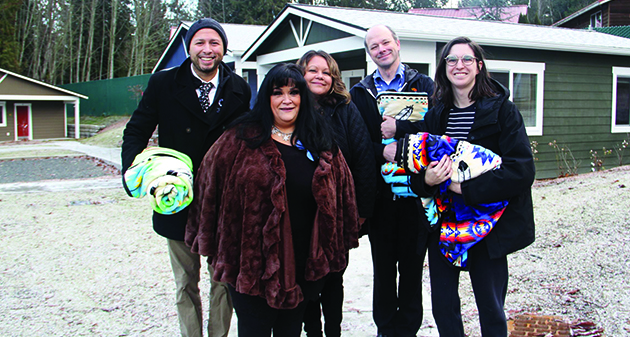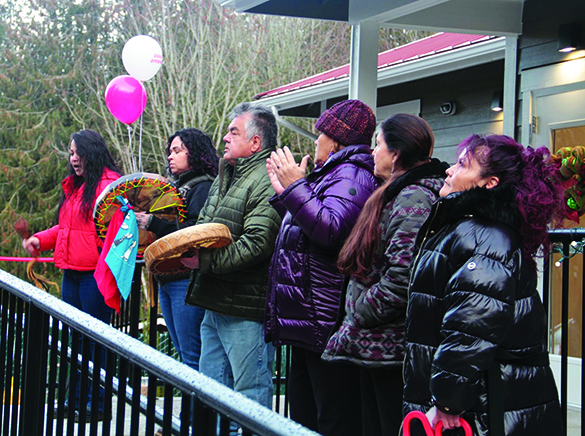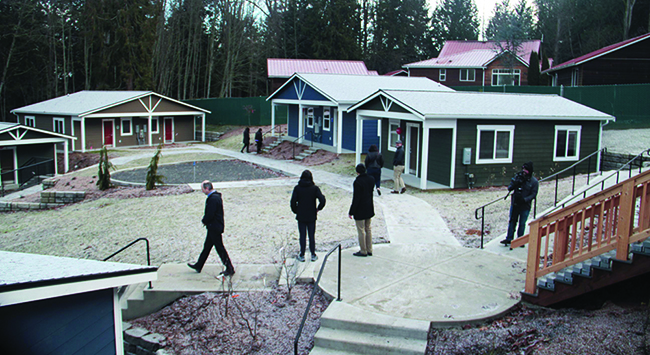
By Shaelyn Smead, Tulalip News
On December 19, Tulalip Tribes hosted the ribbon cutting and blessing for the newly built extension of Village of Hope. The intimate community consists of 17 one- and two-bedroom tiny homes created as permanent residences for unhoused tribal members. Of the 17 tiny houses, seven residents moved in before Christmas, and the other ten are moving in this new year.
The Village of Hope’s extension project was created in 2018 and overseen by the Executive Director of tribal Services, Teri Nelson. It is the first permanent housing available for unhoused tribal members. Compared to the temporary transitional housing that Tulalip has, tenants can stay for as long as they need if they follow the community requirements and their case manager’s expectations.
Teri said, “I’ve been to many conferences and serve on Snohomish County Partnership to End Homelessness as the tribal government board member. Permanent housing has been proven to be more successful than transitional housing. They [residents] don’t have the stressor of the ticking clock, counting down to the moment when they have to move out. Whatever barriers they face, like credit issues, claiming an address, seeking employment, obtaining a driver’s license, etc., they have as much time as they need to accomplish it and better focus on their goals.”
The project was submitted to the Board of Directors in 2019, where they quickly approved the concept. The initiative was shaped more definitively after a stakeholder survey was sent out to community members in 2020. After seeing the high demand for shelters and concerns about chemical dependency, an examination of Snohomish County’s statistics for unhoused people was also taken into consideration. All these helped assess the number of homes needed and the specific needs the Village would strive to provide.

The parcel for the Village was chosen based on its proximity to Behavioral Health, medical care, child care, and other support services that the residents would utilize later on. After seeing the progress with tiny homes and pallet shelters for unhoused communities in various rural areas, it was decided that this would be the route for Village of Hope.
For a project initiated in 2018, the Village of Hope had obstacles to overcome. Due to various landscaping and covid-related complications, the project took much longer than anticipated. Tulalip’s primary source of income from the casinos took a hit during the pandemic, making the project’s financial status questionable. Inflation was starting to affect supply costs, and the demand for help increased. Ultimately after putting out bids in 2021, native-owned Reece Construction won and began to build. To help finance this project, the Village of Hope received funding from the Tulalip Foundation, the state Department of Commerce, and tribal government.
Covid-19 regulations during that time also affected the design and structure of the homes. The initial goal was to have a kitchen within the community building for tenants to use, but with extremely limited gatherings allowed, the plan no longer seemed feasible. The designs for the homes were quickly changed to include kitchenettes for each home.
In the hopes of Covid-19 lifting, the Village of Hope built a community building where tenants can gather, do their laundry, utilize the computer work center, partake in cultural practices, and break bread.
In addition, the Village of Hope wanted its tenants to start on the right foot. The units were set to be fully furnished and include household items like pots, pans, bedding, dinnerware, etc. Each tenant has access to tribal resources, such as medical care, behavioral health care, employment training, counseling services, cultural services, education, vocational training, and more.
The Village had approximately 27 applicants, but the 17 residents chosen were based on the severity of their situations. Each tenant was also designated a case manager to help them set and achieve their goals, ensure they’re following community guidelines, and set them up for success. As each tenant’s case is unique, so are specific requirements.
Teri said that the potential tenants worked closely with tribal staff to help create the community guidelines. “We wanted to create a sense of agency. They’re the ones that are going to have to work at it every day, and if they don’t feel like they have a voice in it, then it might make accomplishing their goals more difficult. We wanted to empower them to build their community and support each other,” She said.

Overall, to apply for the Village’s permanent housing and maintain their residency, they must obey the curfew, the tenants must remain sober, they must meet a specific financial status, have an enrolled tribal member living within the unit, and have zero history of sexual crimes/offenses.
With an understanding of the demand to help tribal homelessness, plans are already being set to build additional housing and accommodate tribal members struggling.
Board Secretary Debra Posey was at the ribbon cutting and spoke fondly about the efforts made toward the Village. “This is what a tribe does. A tribe is about its people and the well-being of its members, and I’m grateful that our people have this opportunity to get out of the cold and start something new. My hands go up to the people who made this possible and the people moving in and beginning their journey. May they finally have some comfort,” Deborah said.
As the moving day came for some tenants, they were overjoyed and overwhelmed with emotion, with some even comparing the experience to the television show Extreme Makeover. Teri noted, “The world is changing so quickly, and some people could be only two paychecks away from losing their home. And that is exactly what happened to some of these people. Homelessness isn’t an identity, it’s people that are experiencing homelessness.”
If you or someone you know require tribal transitional housing, don’t hesitate to get in touch with dparks@tulaliptribes-nsn.gov to see if you qualify.